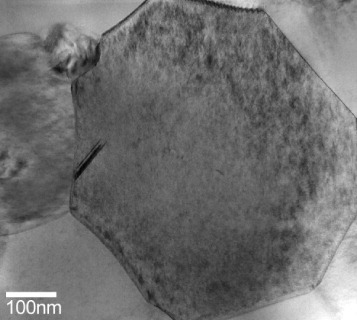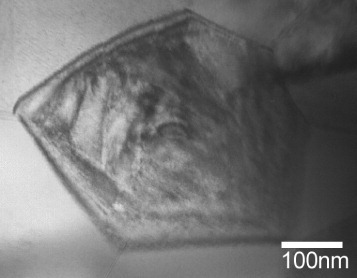Abstract
Environmental concerns are strongly driving the need to replace the lead-based piezoelectric materials currently employed as multilayer actuators. The current review describes both compositional and structural engineering approaches to achieve enhanced piezoelectric properties in lead-free materials. The review of the compositional engineering approach focuses on compositional tuning of the properties and phase behavior in three promising families of lead-free perovskite ferroelectrics: the titanate, alkaline niobate and bismuth perovskites and their solid solutions. The ‘structural engineering’ approaches focus instead on optimization of microstructural features including grain size, grain orientation or texture, ferroelectric domain size and electrical bias field as potential paths to induce large piezoelectric properties in lead-free piezoceramics. It is suggested that a combination of both compositional and novel structural engineering approaches will be required in order to realize viable lead-free alternatives to current lead-based materials for piezoelectric actuator applications.
Introduction
Piezoelectric ceramic materials are widely used in modern industry to transform electrical signals into mechanical strain and vice versa; this dual nature enables piezoelectric materials to be used in electromechanical systems as both sensors and actuators [Citation1]. Current applications of piezoelectric devices extend to automotive fuel injection, accelerometers, piezoelectric transformers and motors, vibration control, micropositioning systems, ultrasound sensors and generators, inkjet printers and many more [Citation2–5]. In the particular case of piezoelectric actuator applications, the piezoelectric strain coefficient (dij) and its temperature dependence are the critical performance metrics.
Currently, piezoceramic actuator materials in commercial use are based on lead titanate zirconate (PbZrO3–PbTiO3 or PZT). PZT possesses superior dielectric and piezoelectric properties arising from the existence of a morphotropic phase boundary (MPB) between tetragonal and rhombohedral phases at ∼48 mol% PbTiO3 content [Citation5–7]. Piezoelectric coefficients (d33) as high as 779 pC N−1 have been reported for modified PZT [Citation8] with Curie temperatures (TC) in the range 300–400 °C. The large properties induced by the MPB and high ferroelectric Curie temperature result in excellent thermal stability in PZT and allow use at operational temperatures ∼175 °C or following temperature transients approaching TC. Additionally, a wide variety of dopants can be used to manufacture a range of ‘hard’ and ‘soft’ PZT piezoelectrics tuned for specific applications [Citation5].
The commercial manufacture and application of lead titanate zirconate have recently become a concern from the viewpoint of health and environmental protection. The evaporation of lead during high-temperature sintering and improper disposal of lead-based materials represent serious health hazards and are now strictly regulated. In the last decade, legislation governing the use of lead containing compounds has been enforced in the EU and the State of California including the draft Directives on Waste from Electrical and Electronic Equipment (WEEE), Restriction of Hazardous Substances (RoHS) and End-of-Life Vehicles (ELV) [Citation9–12]. Therefore, the need to reduce environmental contamination by lead-based substances has created the current drive to develop alternative lead-free piezoelectric materials. Despite tremendous recent progress, currently no lead-free materials possess both the high piezoelectric strain coefficients (dij) and thermal stability required to provide a viable replacement for PZT-based materials for piezoelectric actuator applications [Citation13–15].
Engineering approach to high-performance lead-free piezoelectrics
Traditionally, enhancement of the electromechanical response in piezoelectric materials is achieved by compositional engineering. Following this approach the composition of a material or solid-solution is optimized to bring the material into proximity with a structural instability such as polymorphic phase transition (PPT) or morphotropic phase boundary (MBP) [Citation5]. Hypothetical phase diagrams used for compositional engineering of both PPT- and MPB-based piezoceramics systems and the resulting temperature dependence of the piezoelectric response are illustrated in figure . In both cases, improved piezoelectric properties result from a combination of (i) a ‘softening’ the crystal lattice due to the coexistence of two phases with equivalent free energies and (ii) increased alignment of ferroelectric domains following poling enabled by the large number of equivalent polarization directions from the different symmetries of the two phases. As illustrated in figure (c), MPB-based piezoceramics typically exhibit relatively flat temperature dependence of the poled piezoelectric properties and broad usage temperatures approaching ∼1/2TC. Conversely, PPT-based piezoceramics generally exhibit large temperature dependence of the piezoelectric coefficient and rapid degradation of poled piezoelectric coefficient (due to partial depoling) subsequent to temperature excursions close to the PPT temperature. Recently, the depolarization temperature (Td) has been proposed to describe the temperature at which a poled ferroelectric material completely or partially depolarizes, as determined from pyroelectric measurements [Citation16]. This temperature typically coincides with the ferroelectric Curie temperature. However, in materials exhibiting one or more polymorphic phase transitions below the ferroelectric Curie temperature but above room temperature, Td refers to the temperature of the lowest of these phase transitions.
Figure 1 Characteristic (hypothetical) phase diagrams for perovskite solid solutions exhibiting either a (a) morphotropic phase boundary (MPB) or (b) orthorhombic to tetragonal (O–T) polymorphic phase transformation (PPT). The resulting temperature dependence of the piezoelectric coefficient (c) for hypothetical MPB and PPT materials with the same room-temperature (RT) piezoelectric coefficient and same Curie temperature (Tc), where dotted trend lines indicate degradation of piezoelectric properties due to depolarization at temperatures near TO–T and TC.
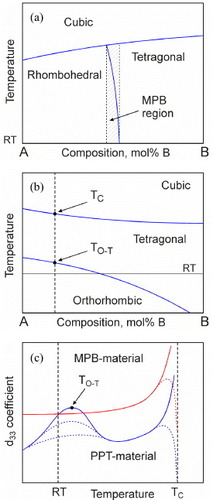
In contrast to compositional engineering approaches, the ‘structurally engineered materials’ approach focuses on controlling the micro and/or nanoscale structure of a piezoelectric material. Significant enhancements of electromechanical properties have been achieved utilizing various structural engineering techniques including: templated grain growth [Citation17, Citation18], grain size optimization [Citation19] and domain engineering [Citation20–22]. The resulting enhancement of piezoelectric properties using several structural engineering approaches is illustrated in figure . The above methods have been applied to a wide variety of existing piezoelectric materials including: bulk and single crystal BaTiO3, PZT ceramics and bulk and single crystal Pb(Mg,Nb)TiO3–PbTiO3. These methods represent an important future path for engineering practical high-performance lead-free piezoelectrics.
Figure 2 Role of ‘engineered materials’ approaches to enhance piezoelectric properties (a) increasing texture fracture in templated grain grown ceramics leads to piezoelectric coefficients approaching the single crystal value, and (2) domain engineering to decrease domain size (enhance domain wall density) leading to increased piezoelectric coefficients.
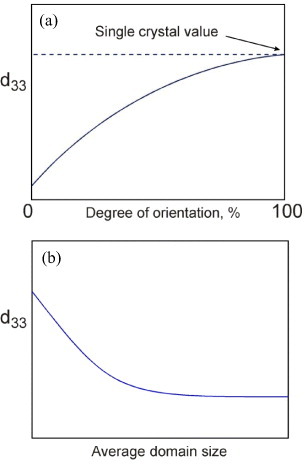
Despite the many opportunities identified by structurally engineered materials, the majority of the search for high-performance lead-free piezoelectrics remains centered on brute force compositional investigations. The following review presents a survey of the current and classical literature on the synthesis and optimization of lead-free perovskite-based piezoelectric ceramics, including some of the recent structural engineering approaches to achieve enhanced properties. Bulk piezoelectricity has been reported in many families of lead-free ceramic materials including: perovskite, tungsten bronze and bismuth layer-structured ferroelectrics as well as various grain-oriented non-ferroelectric materials [Citation15]. However, the relatively higher symmetry of prototype cubic perovskite structure generally leads to improved poling in randomly oriented ferroelectric perovskites and subsequently higher piezoelectric coefficients compared to other lead-free piezoceramic structures. The current review is organized into compositional families including: the titanate perovskite-based materials (BaTiO3, Bi1/2Na1/2TiO3 and Bi1/2K1/2TiO3) and solid solutions (section 3), the alkaline niobate perovskites (KNbO3 and NaNbO3) and solid solutions (section 4), and the bismuth perovskite (BiFeO3 and BiScO3) based materials (section 5). Finally, the status and promise of realizing viable lead-free piezoelectric ceramics for actuator applications is discussed by comparing reported piezoelectric coefficients and depolarization temperatures of both lead-free and lead-based piezoelectric ceramics (section 6).
Titanate perovskites
Perovskite ferroelectrics in which the ferroelectric cation is the B-site Ti4+ ion make up a large fraction of the materials under consideration for lead-free piezoelectrics. Published piezoelectric coefficients and relevant phase transition temperatures for the titanate perovskites and their solid solutions are summarized in table .
Table 1 Room-temperature piezoelectric coefficients (d33), depolarization temperature (Td), and Curie temperatures (TC) for the titanate perovskites. Notes: Where available the measurement method used for determining the piezoelectric coefficient is indicated: ∗ Refers to a Berlincourt-type meter and # to the IEEE resonance method. The type of polymorphic phase transition occurring at Td is indicated as follows: O–T, orthorhombic-tetragonal; PC, transformation to a pseudocubic phase; AFE, antiferroelectric phase transformation, or ?-unknown. Other abbreviations: BKT (Bi1/2K1/2)TiO3 and BNT (Bi1/2Na1/2)TiO3.
Barium titanate
Barium titanate BaTiO3 is the prototype polymorphic phase transition (PPT)-based high-performance piezoceramic material. The discovery of the process for poling barium titanate led to development of the first polycrystalline piezoelectric ceramics [Citation23, Citation24]. The piezoelectric coefficient d33 of pure BaTiO3 fabricated by conventional solid state processing is approximately 190 pC N−1 [Citation25]. Prior to the discovery of PZT-based materials, BaTiO3 was used in naval sonar applications and phonograph needles; however, widespread commercial application of BaTiO3 for piezoelectric actuators remains limited by its low Curie temperature (TC=120 °C) [Citation5] which severely constrains the operational (or transient exposure) temperature for BaTiO3 materials.
Recently, structural engineering approaches by several groups have led to significantly improved piezoelectric response in BaTiO3. Introduction of fine-scale ferroelectric domains into barium titanate ceramics prepared from nano-scale particles and densified by microwave sintering results in a high d33 value of 350 pC N−1 [Citation26–28]. In other work, a piezoelectric coefficient of 460 pC N−1 is achieved in high-quality hydrothermally synthesized BaTiO3 powders and an optimized conventional sintering process, resulting in fine grain ceramics, with grain sizes on order of 1–2 μm [Citation29, Citation30]. A separate report also describes the tendency of the piezoelectric coefficient to increase with decreasing domain size [Citation19]. This increased d33, in small grain and small domain size randomly oriented ceramics, has also been combined with the templated grain growth technique and further enhancement in the piezoelectric coefficient reported. A d33 value of 788 pC N−1 was reported in [Citation110] grain oriented BaTiO3 ceramics with submicron domain size [Citation21]. These findings clearly demonstrate the large piezoelectric response achievable in optimally prepared ceramics (up to 460 pC N−1 in hydrothermal BaTiO3) and that structural engineering is a key concept in achieving enhanced piezoelectric properties in lead-free piezoceramics (up to ∼800 pC N−1 in grain-oriented BaTiO3).
Bismuth potassium titanate
Bismuth potassium titanate (Bi1/2K1/2)TiO3 (BKT) is another common lead-free ferroelectric ceramic material. (Bi1/2K1/2)TiO3 was originally fabricated by Popper et al [Citation31] in 1957 and its ferroelectricity including Curie temperature of 370 °C was confirmed later by Buhrer [Citation32]. At room temperature, (Bi1/2K1/2)TiO3 has the perovskite structure with tetragonal symmetry and exhibits a second phase transition to a pseudocubic structure at around 300 °C. (Bi1/2K1/2)TiO3 ceramics are difficult to sinter [Citation33], however, high densities of 97% of theoretical can be achieved by hot pressing methods yielding piezoelectric d33 coefficients close to 70 pC N−1 [Citation34]. Hot pressed (Bi1/2K1/2)TiO3 shows increased TC of 410–435 °C and the temperature of the second phase transition increases to 315–340 °C. Slightly improved piezoelectric properties in (Bi1/2K1/2)TiO3 ceramics are obtained using an optimized poling procedure resulting in a d33 of 82 pC N−1 [Citation35]. Alternatively, doping with bismuth and using sintering aids has further increased the d33 value to 100 pC N−1 [Citation36].
Bismuth sodium titanate
Bismuth sodium titanate, (Bi1/2Na1/2)TiO3 (BNT), first reported by Smolenskii et al in 1960, is another important lead-free piezoelectric material [Citation37]. (Bi1/2Na1/2)TiO3 was found to be a perovskite-type ferroelectric at room temperature and exhibits relaxor ferroelectric behavior. A diffuse phase transformation in the temperature range 200–320 °C is observed in (Bi1/2Na1/2)TiO3 corresponding to a transition from rhombohedral to tetragonal symmetry [Citation38–41]. This transition is rather complex and it is believed that it takes place through an intermediate orthorhombic antiferroelectric phase [Citation42]. The preparation of dense (Bi1/2Na1/2)TiO3 ceramics is difficult, requiring sintering temperatures above 1200 °C, which results in significant loss of bismuth. High leakage currents and high coercive field negatively impact the poling process and polarization saturation is difficult to achieve in conventionally fabricated (Bi1/2Na1/2)TiO3 samples. However, dense ceramics have been obtained using excess Bi or hot pressing sintering methods, yielding samples with saturated polarization loops [Citation43]. (Bi1/2Na1/2)TiO3 ceramics fabricated by these latter techniques have piezoelectric d33 coefficients 94–98 pC N−1 and a depolarization temperature of 200 °C [Citation37, Citation42, Citation43].
Bismuth potassium titanate–barium titanate solid solution
Both barium titanate (BaTiO3) and bismuth potassium titanate ((Bi1/2K1/2)TiO3) are tetragonal ferroelectric materials with Curie temperatures of 120 and 370 °C, respectively. The binary system (Bi1/2K1/2)TiO3–BaTiO3 (BKT–BT) has been investigated in order to obtain a compound with enhanced piezoelectric properties and higher TC than pure BaTiO3. The solid solution x(Bi1/2K1/2)TiO3–(1−x)BaTiO3 is single phase ferroelectric perovskite over the complete compositional range and shows close to linear dependence of the Curie temperature on (Bi1/2K1/2)TiO3 concentration, as shown in figure [Citation15]. In compositions above x=60 mol% (Bi1/2K1/2)TiO3, a second transition from tetragonal to an intermediate pseudocubic phase is observed at around 300 °C and remains nearly independent of (Bi1/2K1/2)TiO3 concentration. Values of the piezoelectric d33 coefficient do not change significantly with composition and are in the range 60–70 pC N−1. The highest d33 of 100 pC N−1 is obtained for x=5 mol% (Bi1/2K1/2)TiO3 with the addition of manganese, however, this composition has a relatively low Curie temperature of 168 °C. Compositions with x>60 mol% (Bi1/2K1/2)TiO3 show good thermal stability of the coupling coefficient up to their depolarization temperature, Td∼250 °C, and are considered attractive for piezoelectric applications even with their low d33's∼70 pC N−1. Structural engineering in (Bi1/2K1/2)TiO3–BaTiO3 leads to a significantly improved d33 value of 121 pC N−1, for x=10 mol% (Bi1/2K1/2)TiO3 textured using the templated grain growth technique [Citation44, Citation45].
Figure 3 Phase diagram of the (Bi1/2K1/2)TiO3–BaTiO3 solid solution (after [Citation15]).

Bismuth sodium titanate–barium titanate solid solution
It might be expected that the solid solution of the rhombohedral ferroelectric bismuth sodium titanate (Bi1/2Na1/2)TiO3 and a tetragonal material such as barium titanate would exhibit a rhombohedral–tetragonal morphotropic phase boundary (MPB) as in the prototype PZT system. Subsequently this binary system (Bi1/2Na1/2)TiO3–BaTiO3 (BNT–BT) was investigated by Takenaka et al [Citation46, Citation47] and the existence of an MBP was confirmed at around 6–7 mol% BaTiO3, as illustrated in figure . Enhanced dielectric constant, electromechanical coupling coefficient, and piezoelectric properties (d33=125 pC N−1), compared to unmodified BNT (d33=64 pC N−1), were observed at the MBP [Citation48, Citation49]. Piezoelectric coefficients in the range 122–176 pC N−1 at the MPB have been reported by various researchers [Citation50–53]; d33 values of 208 pC N−1 were achieved in lithium-modified (Bi1/2Na1/2)TiO3–BaTiO3 [Citation54, Citation55]. Whereas the MPB composition for (Bi1/2Na1/2)TiO3–BaTiO3 has a relatively high TC of 288 °C, a low depolarization temperature (Td) of 150 °C has been reported. By analogy to the (Bi1/2Na1/2)TiO3 end member, the low Td arises owing to a polymorphic phase transformation to an antiferroelectric (AFE) phase, as substantiated by high-temperature dielectric and polarization hysteresis measurements [Citation46].
Figure 4 Phase diagram for the (Bi1/2Na1/2)TiO3–BaTiO3 solid solution (after [Citation46]).
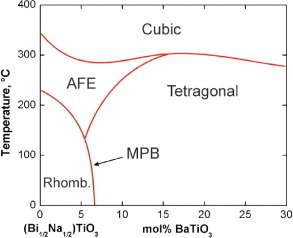
Bismuth sodium titanate–bismuth potassium titanate solid solution
The solid solution of bismuth sodium titanate, (Bi1/2Na1/2)TiO3 (BNT), and bismuth potassium titanate, (Bi1/2K1/2)TiO3 (BKT), was synthesized by Elkechai et al in 1996 [Citation56] and an increase in piezoelectric properties was observed in this system close to the rhombohedral to tetragonal morphotropic phase boundary, shown in figure . The existence of an MPB between (Bi1/2Na1/2)TiO3 and (Bi1/2K1/2)TiO3 in the compositional range 16–20 mol% (Bi1/2K1/2)TiO3 was later substantiated by Sasaki et al [Citation57] based on structural studies indicating coexistence of rhombohedral and tetragonal phases as well as the corresponding compositionally dependant peaks in the dielectric, piezoelectric and electromechanical coefficients. More recent studies [Citation58–63] confirm high piezoelectric properties (d33 in the range 140–192 pC N−1) at the MPB composition. The Curie temperature of the MPB (TC=280–300 °C) is higher than that of pure (Bi1/2Na1/2)TiO3 as expected, however, the depolarization temperature (due to a polymorphic phase transformation to the intermediate pseudocubic phase) is quite low reaching a minimum (Td=140 °C) at the MPB.
Figure 5 Phase diagram for the (Bi1/2Na1/2)TiO3–(Bi1/2K1/2)TiO3 solid solution (after [Citation56, Citation59, Citation62]).
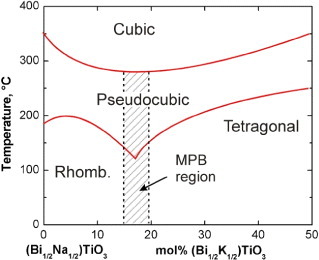
Barium titanate–bismuth sodium titanate–bismuth potassium titanate ternary solid solution
The ternary BaTiO3–(Bi1/2Na1/2)TiO3–(Bi1/2K1/2)TiO3 (BT–BNT–BKT) solid solution (phase diagram shown in figure ) has also been widely investigated owing to relatively large Curie temperatures and high piezoelectric properties. BT–BNT–BKT exhibits a tetragonal–rhombohedral MPB and while maintaining piezoelectric properties similar to its end members. Reported values of the piezoelectric d33 coefficient are in the range 135–191 pC N−1 and are inversely proportional to the observed depolarization temperature, which is prohibitively low (Td∼110 °C) at the MPB [Citation64–66]. For compositions with a more reasonable depolarization temperature (Td=197 °C) a maximum d33 of 135 pC N−1 was obtained [Citation67]. Further enhanced performance was found in Li-modified BT–BNT–BKT, exhibiting a d33 of 205 pC N−1, with a depolarization temperature Td=210 °C [Citation68].
Figure 6 Ternary phase diagram for the BaTiO3–(Bi1/2Na1/2)TiO3–(Bi1/2K1/2)TiO3 solid solution (after [Citation65, Citation67]).

Alkaline niobates
The alkaline niobates and their solid solutions are another interesting family of lead-free perovskites. Significant recent experimental efforts in these materials have been undertaken largely following Saito et al's 2004 Nature paper and the accompanying editorial ‘Lead Free at Last’ [Citation13, Citation69]. While exhibiting high piezoelectric coefficients, particularly in structurally engineered ceramics these materials are still limited in application by low depolarization temperatures arising from an orthorhombic to tetragonal (O–T) PPT near room temperature. Published room-temperature piezoelectric coefficients and phase transformation temperatures for the alkaline niobates and solid solutions are compiled in table .
Table 2 Room-temperature piezoelectric coefficients (d33), depolarization temperature (Td) and Curie temperatures (TC) for the alkaline niobate perovskites. For all cases report the Td is associated with an orthorhombic–tetragonal PPT (O–T). Notes: Where available the measurement method used for determining the piezoelectric coefficient is indicated: ∗ refers to a Berlincourt-type meter and # to the IEEE resonance method. O–T: orthorhombic–tetragonal.
Potassium niobate
In 1951, Matthias and Remeika [Citation70] discovered ferroelectricity in KNbO3 reporting both its Curie temperature (TC=435 °C) and a second transition temperature at around 225 °C. Further investigations revealed a sequence of phase transformations similar to those observed in BaTiO3 (rhombohedral–orthorhombic–tetragonal–cubic) occurring at −10, 220 and 420 °C, respectively [Citation71]. Pure KNbO3 ceramics are difficult to fabricate [Citation5], however, single crystals have been produced and interesting nonlinear electro-optic properties and piezoelectric coefficients along certain crystallographic directions have been reported [Citation72–74]. High coupling coefficients (kT=0.69) and excellent temperature stability up to 160 °C make KNbO3 single crystals attractive for ultrasonic and acoustic wave transducer applications, however, other uses of KNbO3's piezoelectric properties are limited [Citation75]. Recent studies on bulk KNbO3 ceramics report piezoelectric properties with a d33 coefficient of 97 pC N−1 [Citation76] and large shear-mode d15 constant of 207 pC N−1 [Citation77, Citation78].
Sodium niobate
The other alkaline niobate end member, sodium niobate NaNbO3, is also an orthorhombic perovskite at room temperature, transforming into the tetragonal phase at 370 °C and eventually to cubic above 640 °C [Citation79]. At room temperature, NaNbO3 is antiferroelectric and as such exhibits no piezoelectric activity in its pure form [Citation5].
Potassium niobate–sodium niobate solid solution
The potassium niobate–sodium niobate, KNbO3–NaNbO3 (alternatively (K,Na)NbO3 or KNN) solid solution is widely considered as one of the most promising lead-free alternatives to the conventional piezoelectric ceramics. Both end members of the solid solution are orthorhombic at room temperature and early work on the ceramics in this system indicated multiple temperature-induced phase transformations and morphotropic phase boundaries comprising a rather complex phase diagram, shown in figure [Citation80, Citation81]. Piezoelectric d33 coefficients for KNN are reported in the range 80–160 pC N−1 and enhanced electromechanical properties observed near the 53 mol% sodium niobate composition [Citation82–85].
Figure 7 Phase diagram of the KNN solid solution (after [Citation5]).
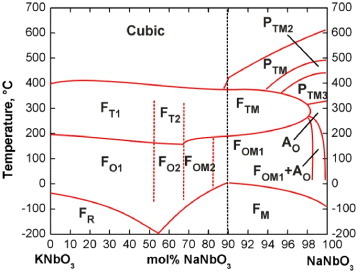
Processing of KNN ceramics is problematic owing to the low sintering temperatures required because of the instability of the KNN phase above 1140 °C and volatility of the alkali species at high temperatures. This low temperature requirement makes it difficult to obtain ceramics of high sintered density [Citation5, Citation85]. However, reasonable piezoelectric properties (d33=100 pC N−1) of KNN have been achieved by optimizing the conventional sintering process [Citation85]. The incorporation of liquid phase sintering aids (K4CuNb8O23, K5.4CuTa10O29 and CuO) [Citation86–88] can result in densities up to 97.5% theoretical. Liquid phase sintering has reduced sintering temperatures to as low as 950 °C, and high-field d33's of 180–270 pC N−1 have been reported. Densification of KNN ceramics is also significantly improved by hot-pressing, with sintered ceramics reaching ∼99% of the theoretical density and the resulting piezoelectric constant nearly twice the value of conventionally sintered KNN [Citation89–91]. Spark plasma sintering has also resulted in high-density KNN ceramics and with enhanced piezoelectric coefficients (d33=148 pC N−1) [Citation92–94].
Numerous compositional engineering approaches have been explored to optimize the piezoelectric properties of KNN materials. However, nearly all of these approaches achieve ‘enhanced’ properties by shifting the orthorhombic–tetragonal polymorphic phase transition temperature (TO–T) to slightly above or below room temperature. As discussed above and illustrated in figure , this close proximity to a PPT results in significant softening of the piezoelectric properties (large d33), however, comes at the cost of large temperature dependence of the piezoelectric response and poor stability of the poled domain state in most modified KNN compositions.
Compositionally engineered KNN systems modified by LiTaO3 and LiSbO3 have been studied the most intensively. KNN in combination with tetragonal LiTaO3 exhibits a morphotropic phase boundary between orthorhombic and tetragonal phases at 4–5 mol% of LiTaO3 accompanied by enhancement of piezoelectric properties; d33 coefficients have been reported in the range 200–259 pC N−1 [Citation95–99]. The addition of LiSbO3 to pure KNN shifts the orthorhombic to tetragonal polymorphic phase transition temperature down from 200 °C to nearly room temperature (TOT∼35 °C) and increases the room-temperature d33 coefficient; reaching a maximum (d33=250–265 pC N−1) at approximately 5 mol% of LiSbO3 content [Citation100–102]. In the work of Saito et al [Citation13], optimization of the KNN by separate lithium, tantalum and antimony additions (specifically (K0.44Na0.52Li0.04)(Nb0.86Ta0.10Sb0.04)O3, the so-called LF4 composition) yielded a further increase of d33 to 300 pC N−1. In the same work, the properties of the LF4 composition were further enhanced by the reactive template grain growth method, producing d33 values as high as 416 pC N−1 in 〈001〉 oriented ceramics (LF4T) [Citation13]. The observed enhancement of the piezoelectric coefficient was at first attributed to an MBP between orthorhombic and tetragonal phases. However, the authors themselves and more recent studies observed temperature dependence of the electromechanical properties near the room temperature and the existence of the orthorhombic–tetragonal PPT near room temperature in both the LF4 and LF4T compositions [Citation13, Citation103].
Recently, an alternative modification of the KNN system has been proposed [Citation104, Citation105]. In this work it is shown that the orthorhombic to tetragonal phase transition temperature in KNN can be effectively lowered by addition of CaTiO3. The authors show that the orthorhombic to tetragonal transition temperature can be reduced by 1 wt% CaTiO3 addition to below room temperature. This results in improved thermal stability and reduced temperature dependence of the piezoelectric response in the range −50 to 200 °C, while maintaining acceptable piezoelectric properties d33=210 pC N−1 [Citation104, Citation105].
Bismuth perovskites
The low depolarization temperatures associated with polymorphic phase transformations in both the titanate and alkaline niobate perovskites remain the main obstacle in the commercialization of lead-free piezoelectric actuators. Increasing both the Td and TC should be achievable by creating solid solutions between the above materials and alternative high-TC end members such as the bismuth perovskites. The prototype bismuth perovskite is bismuth ferrite BiFeO3, a rhombohedral ferroelectric with a large local spontaneous polarization (Ps=100 μC cm−2) and high Curie temperature (TC=870 °C) [Citation106–109]. BiFeO3 has been extensively studied owing to its multiferroic properties, simultaneously exhibiting antiferromagnetism and ferroelectricity. Recently, incorporation of bismuth perovskites into lead-based perovskites has been shown to be effective in increasing both Tc and d33, exemplified by the BiScO3–PbTiO3 system [Citation110, Citation111]. Reported piezoelectric coefficients and transition temperatures for the lead-free bismuth perovskites and their solid solutions are listed in table .
Table 3 Room-temperature piezoelectric coefficients (d33), depolarization temperature (Td), and Curie temperatures (TC) for the bismuth perovskites. Notes: Where available the measurement method used for determining the piezoelectric coefficient is indicated: ∗ refers to a Berlincourt-type meter. The type of polymorphic phase transition occurring at Td is indicated as follows: O–T, orthorhombic–tetragonal, or ?-unknown.
Bismuth perovskite solid solutions with KNN
There have been several recent reports on the incorporation of bismuth perovskites into solid solutions with KNN. The solid solution BiScO3–KNN has been synthesized with a large piezoelectric coefficient d33=253 pC N−1 and high Curie temperature TC=351 °C. Unfortunately, the orthorhombic–tetragonal transition temperature is largely unchanged giving Td of only 100 °C in this material. Bismuth ferrite solid solutions have also been investigated in KNN ceramics [Citation112]. A complex KNN solid solution with BiFeO3, SrTiO3 and lithium has been reported with d33=155 pC N−1, Td=30 °C and TC=370 °C [Citation113].
Bismuth ferrite–barium titanate solid solution
Previously, ceramic bismuth ferrite–barium titanate, BiFeO3–BaTiO3 solid solutions have been synthesized by several groups [Citation114, Citation115]. The BiFeO3–BaTiO3 system has been shown to form a single phase perovskite solid solution within the complete compositional range, its room temperature symmetry is reported to be rombohedral at low BaTiO3 content, switching to cubic (or perhaps pseudocubic) at 33 mol% BaTiO3, and eventually becoming tetragonal for BaTiO3 content greater than 92 mol%, as shown in figure . However, poor control of the bismuth volatility and iron oxidation state have generally led to low DC electrical resistivity and the inability to pole BiFeO3–BaTiO3 ceramics.
Figure 8 Phase diagram for the BaTiO3–BiFeO3 solid solution (after [Citation116]).

Recently, using MnO2 modification and optimized solid state sintering conditions the current authors have shown that BiFeO3–BaTiO3 ceramics can be poled and show measurable piezoelectric coefficients in the range compositional range of 22–40 mol% BaTiO3. These materials exhibit d33 coefficients up to 115 pC N−1, with a TC close to 600 °C and depolarization temperatures above 400 °C [Citation116]. Additionally, high-field piezoelectric strain coefficients of up to ∼300 pC N−1 are observed for the 33 mol% BaTiO3 composition. However, large strain hysteresis suggests poor stability of poled domain state and significant domain switching contributions in the latter composition. Transmission electron microscopy (TEM) investigations in these materials reveal frustrated nanoscale domain patterns, shown in figure , which could explain the difficulty in obtaining stably poled ceramics.
Using a structural engineering approach the authors were able to induce large low field piezoelectric coefficients by application of large dc bias. Specifically, application of a 40 kV cm−1 dc bias resulted in an enhanced piezoelectric response and a low-field d33 coefficient of 150 pC N−1 [Citation117]. Following observations in other domain engineered ceramics, the application of a large dc bias in BiFeO3–BaTiO3 is believed to create an ‘engineered’ ordered domain state leading to higher extrinsic and intrinsic contributions to the piezoelectric coefficient in BF–BT ceramics. This is in strong contrast to the expected suppression of extrinsic contributions and reduction in the low field piezoelectric coefficient typically observed in ferroelectric ceramics at large dc bias. Evidence of this electric field induced engineered domain state can been found in the weak residual banding of the domain structure observed by TEM following high field poling, as shown in figure .
Discussion and continued developments in lead-free piezoceramics
The above review identifies many significant recent advances in the search for lead-free materials for piezoceramic actuator applications. However, it can be difficult to appreciate the significant limitations associated with the vast majority of these materials. Zhang et al have proposed the use of graphs of d33 over Td in order to make more reliable comparisons both among and between lead-based and lead-free piezoelectrics materials [Citation4, Citation14, Citation118]. Such plots provide a concise illustration of the relationship between the room-temperature piezoelectric coefficient and phase transition temperatures. They also provide an indication of the temperature dependence and maximum usage temperatures of the various piezoelectric materials and families of materials.
Following this convention, the properties of the lead-free materials summarized in this work are reported in figure . Two separate graphs are provided the first including only the lead-free materials and a second with a wide range of lead-based materials superimposed. Reviewing these graphs the following general trends are readily identified. Firstly, within a given compositional family the room-temperature d33 coefficients increase as the Td decreases. (The inherent consequences reduced of reduced Td are increased temperature dependence of d33 and reduced maximum usage temperature). Secondly, the majority of the alkaline niobates (triangles) have depolarization temperatures below 100 °C (associated with the orthorhombic–tetragonal PPT) which is generally too low for these materials to be of broad commercial interest (as is the case for pure BaTiO3). Thirdly, the titanates in general have both moderate d33 values (100–200 pC N−1) and moderate depolarization temperatures (100–300 °C). Fourthly, the bismuth perovskites have among the highest depolarization temperatures reported for any of the perovskite piezoceramic systems (including lead-based materials). Finally, the lead-based materials still maintain a clear performance advantage, universally possessing the largest d33 coefficients, while maintaining high Curie temperatures, TC>200 °C.
Figure 11 Piezoelectric coefficient over depolarization temperature for (a) the various families of lead-free and (b) including lead-based piezoelectric ceramics.
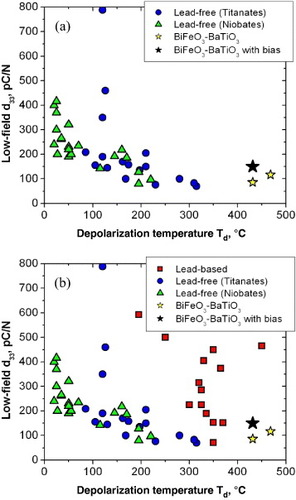
In addition to the above general trends, these graphs also suggest possible paths for future development. The vertically stacked circles at ∼120 °C represent the effect of various structural engineering approaches in pure BaTiO3 ceramics. While the TC of BaTiO3 ceramics is still too low for these materials to be of broad interest, textured-domain engineered BaTiO3 is the current benchmark piezoceramic material with a low field d33∼800 pC N−1. The stacked triangles at ∼25 °C also illustrated the effect of structural engineering, where a textured KNN material (LF4T) exhibits a significant enhancement of the d33 coefficient over randomly oriented ceramics of the same composition (LF 4). Finally, the BiFeO3–BaTiO3 materials (stars) reveal enhancement of d33 owing to field-induced ordering of the nanoscale domain structure in this system. On the basis of these strong enhancements observed in ‘structurally engineered’ piezoceramics it is suggested that more effort should be focused on understanding these effects and in applying them to existing materials rather than continued brute force compositional investigations.
References
- TresslerJ FAlkoySDoganANewnhamR E 1999 Composites A 30 477 http://dx.doi.org/10.1016/S1359-835X(98)00137-7
- UchinoinK 1997 Present status of piezoelectric/electrostrictive actuators and remaining problems Piezoelectric Actuators and Ultrasonic Motors Boston, MA Kluwer
- SetterN 2005 Ceramics Laboratory, EPFL Swiss Federal Institute of Technology, Lausanne
- RandallC AKelnbergerAYangG YEitelR EShroutT R 2005 J. Electroceram. 14 177 http://dx.doi.org/10.1007/s10832-005-0956-5
- JaffeBCookW RJaffeH 1971 Piezoelectric Ceramics New York Academic
- SawaguchiE 1953 J. Phys. Soc. Japan 8 615 http://dx.doi.org/10.1143/JPSJ.8.615
- YamamotoT 1996 Japan. J. Appl. Phys. 1 35 5104 http://dx.doi.org/10.1143/JJAP.35.5104
- DonnellyN JShroutT RRandallC A 2007 J. Am. Ceram. Soc. 90 490 http://dx.doi.org/10.1111/j.1551-2916.2006.01450.x
- 2003 Off. J. Eur. Union 46 14
- 2003 Off. J. Eur. Union 46 4
- 2006 California Health and Safety Code 25214.9–25214.10.2
- 2000 Off. J. Eur. Union L 269 34
- SaitoYTakaoHTaniTNonoyamaTTakatoriKHommaTNagayaTNakamuraM 2004 Nature 432 84 http://dx.doi.org/10.1038/nature03028
- ZhangS JXiaRShroutT R 2007 J. Electroceram. 19 251 http://dx.doi.org/10.1007/s10832-007-9056-z
- TakenakaTNagataHHirumaY 2008 Japan. J. Appl. Phys. 47 3787 http://dx.doi.org/10.1143/JJAP.47.3787
- ShroutT RZhangS J 2007 J. Electroceram. 19 111
- TaniT 1998 J. Korean Phys. Soc. 32 S1217
- MessingG L et al 2004 Crit. Rev. Solid State. Mater. Sci. 29 45 http://dx.doi.org/10.1080/10408430490490905
- WadaSYakoKKakemotoHTsurumiTKiguchiT 2005 J. Appl. Phys. 98 014109 http://dx.doi.org/10.1063/1.1957130
- ParkS-EShroutT R 1997 J. Appl. Phys. 82 1804 http://dx.doi.org/10.1063/1.365983
- WadaSTakedaKMuraishiTKakemotoHTsurumiTKimuraT 2008 Ferroelectrics 373 11 http://dx.doi.org/10.1080/00150190802408531
- ParkS EWadaSCrossL EShroutT R 1999 J. Appl. Phys. 86 2746 http://dx.doi.org/10.1063/1.371120
- GrayR B 1949 Transducer and method of making the same United States Patent Office USA Erie Resistor Corporation
- RobertsS 1947 Phys. Rev. 71 890 http://dx.doi.org/10.1103/PhysRev.71.890
- BechmannR 1956 J. Acoust. Soc. Am. 28 347 http://dx.doi.org/10.1121/1.1908324
- TakahashiHNumamotoYTaniJMatsutaKQiuJ HTsurekawaS 2006 Japan. J. Appl. Phys. 2 45 L30 http://dx.doi.org/10.1143/JJAP.45.L30
- TakahashiHNumamotoYTaniJTsurekawaS 2006 Japan. J. Appl. Phys. 1 45 7405 http://dx.doi.org/10.1143/JJAP.45.7405
- TakahashiHNumamotoYTaniJTsurekawaS 2008 Japan. J. Appl. Phys. 47 8468 http://dx.doi.org/10.1143/JJAP.47.8468
- KarakiTYanKAdachiM 2007 Japan. J. Appl. Phys. 1 46 7035 http://dx.doi.org/10.1143/JJAP.46.7035
- KarakiTYanKMiyamotoTAdachiM 2007 Japan. J. Appl. Phys. 46 L97 http://dx.doi.org/10.1143/JJAP.46.L97
- PopperPRuddlesdenS NInglesT A 1957 Trans. Br. Ceram. Soc. 56 9
- BuhrerC F 1962 J. Chem. Phys. 36 798 http://dx.doi.org/10.1063/1.1732613
- WadaTToyoikeKImanakaYMatsuoY 2001 Japan. J. Appl. Phys. 1 40 5703 http://dx.doi.org/10.1143/JJAP.40.5703
- HirumaYAoyagiRNagataHTakenakaT 2005 Japan. J. Appl. Phys. 1 44 5040 http://dx.doi.org/10.1143/JJAP.44.5040
- HirumaYMarumoKAoyagiRNagataHTakenakaT 2008 J. Electroceram. 21 296 http://dx.doi.org/10.1007/s10832-007-9146-y
- HirumaYNagataHTakenakaT 2007 Japan. J. Appl. Phys. 1 46 1081 http://dx.doi.org/10.1143/JJAP.46.1081
- SmolenskiiG AIsupovV AAgranovskayaA IKrainikN N 1961 Sov. Phys.—Solid State 2 2651
- JonesG OThomasP A 2002 Acta Crystallogr. B 58 168 http://dx.doi.org/10.1107/S0108768101020845
- RolederKSuchaniczJKaniaA 1989 Ferroelectrics 89 1
- SuchaniczJ 1995 Ferroelectrics 172 455 http://dx.doi.org/10.1080/00150199508018512
- SuchaniczJRolederKKaniaAHanderekJ 1988 Ferroelectrics 77 107 http://dx.doi.org/10.1080/00150198808223232
- SakataKMasudaY 1974 Ferroelectrics 7 347 http://dx.doi.org/10.1080/00150197408238042
- NagataHShinyaTHirumaYTakenakaT 2004 Ceram . Trans. 167 8
- NemotoMHirumaYNagataHTakenakaT 2009 Japan. J. Appl. Phys. 48
- NemotoMHirumaYNagataHTakenakaT 2008 Japan. J. Appl. Phys. 47 3829 http://dx.doi.org/10.1143/JJAP.47.3829
- TakenakaTMaruyamaKSakataK 1991 Japan. J. Appl. Phys. 1 30 2236 http://dx.doi.org/10.1143/JJAP.30.2236
- TakenakaTNagataH 1999 Electroceramics in Japan I NMizutani et al Clausthal Zellerfe Trans Tech Publications p 57
- TakenakaTSakataKTodaK 1990 Ferroelectrics 106 375
- LiH DFengC DYaoW L 2004 Mater. Lett. 58 1194 http://dx.doi.org/10.1016/j.matlet.2003.08.034
- ChenMXuQKimB HAhnB KKoJ HKangW JNamO J 2008 J. Eur. Ceram. Soc. 28 843 http://dx.doi.org/10.1016/j.jeurceramsoc.2007.08.007
- XuC GLinD MKwokK W 2008 Solid State Sci. 10 934 http://dx.doi.org/10.1016/j.solidstatesciences.2007.11.003
- ChuB JChenD RLiG RYinQ R 2002 J. Eur. Ceram. Soc. 22 2115 http://dx.doi.org/10.1016/S0955-2219(02)00027-4
- OhTKimM H 2006 Mater. Sci. Eng. B 132 239 http://dx.doi.org/10.1016/j.mseb.2006.02.070
- LinDKwokK WChanH L W 2008 Solid State Ion. 178 1930
- LinD MXiaoD QZhuJ GYuP 2006 J. Eur. Ceram. Soc. 26 3247 http://dx.doi.org/10.1016/j.jeurceramsoc.2005.09.038
- ElkechaiOManierMMercurioJ P 1996 Phys. Status Solidi a 157 499 http://dx.doi.org/10.1002/pssa.2211570234
- SasakiAChibaTMamiyaYOtsukiE 1999 Japan. J. Appl. Phys. 1 38 5564 http://dx.doi.org/10.1143/JJAP.38.5564
- YangZ PLiuBWeiL LHouY T 2008 Mater. Res. Bull. 43 81 http://dx.doi.org/10.1016/j.materresbull.2007.02.016
- YoshiiKHirumaYNagataHTakenakaT 2006 Japan. J. Appl. Phys. 1 45 4493 http://dx.doi.org/10.1143/JJAP.45.4493
- ZhaoS CLiG RDingA LWangT BYinQ R 2006 J. Phys. D: Appl. Phys. 39 2277 http://dx.doi.org/10.1088/0022-3727/39/10/042
- ZhangY RLiJ FZhangB P 2008 J. Am. Ceram. Soc. 91 2716 http://dx.doi.org/10.1111/j.1551-2916.2008.02469.x
- HirumaYYoshiiKNagataHTakenakaT 2008 J. Appl. Phys. 103 084121 http://dx.doi.org/10.1063/1.2903498
- OhT 2006 Japan. J. Appl. Phys. 1 45 5138 http://dx.doi.org/10.1143/JJAP.45.5138
- HirumaYYoshiiKAoyagiRNagataHTakenakaT 2006 Electroceramies Japan Ix KKatrayama et al Stafa-zurich Trans Tech Publications p 23
- NagataHYoshidaMMakiuchiYTakenakaT 2003 Japan. J. Appl. Phys. 1 42 7401 http://dx.doi.org/10.1143/JJAP.42.7401
- ZhangS JShroutT RNagataHHirumaYTakenakaT 2007 IEEE Trans. Ultrason. Ferroelectr. Freq. Control 54 910 http://dx.doi.org/10.1109/TUFFC.2007.336
- MakiuchiYAoyagiRHirumaYNagataHTakenakaT 2005 Japan. J. Appl. Phys. 1 44 4350 http://dx.doi.org/10.1143/JJAP.44.4350
- LinD MXiaoD QZhuJ GYuP 2005 Phys. Status Solidi a 202 R89 http://dx.doi.org/10.1002/pssa.200510034
- CrossE 2004 Nature 432 24 http://dx.doi.org/10.1038/nature03142
- MatthiasB TRemeikaJ P 1951 Phys. Rev. 82 727 http://dx.doi.org/10.1103/PhysRev.82.727
- ShiraneGDannerHPavlovicAPepinskyR 1954 Phys. Rev. 93 672 http://dx.doi.org/10.1103/PhysRev.93.672
- NakamuraKKawamuraY 2000 IEEE Trans. Ultrason. Ferroelectr. Freq. Control 47 750 http://dx.doi.org/10.1109/58.842064
- ZgonikMSchlesserRBiaggioIVoitETscherryJGunterP 1993 J. Appl. Phys. 74 1287 http://dx.doi.org/10.1063/1.354934
- NakamuraKOshikiM 1997 Appl. Phys. Lett. 71 3203 http://dx.doi.org/10.1063/1.120290
- DavisMKleinNDamjanovicDSetterNGrossAWesemannVVernaySRytzD 2007 Appl. Phys. Lett. 90 062904 http://dx.doi.org/10.1063/1.2472524
- NagataHMatsumotoKHirosueTHirumaYTakenakaT 2007 Japan. J. Appl. Phys. 1 46 7084 http://dx.doi.org/10.1143/JJAP.46.7084
- LiE ZKakemotoHHoshinaTTsurumiT 2008 Japan. J. Appl. Phys. 47 7702 http://dx.doi.org/10.1143/JJAP.47.7702
- HikitaKHirumaYNagataHTakenakaT 2009 Japan. J. Appl. Phys. 48 07GA05 http://dx.doi.org/10.1143/JJAP.48.07GA05
- WoodE A 1951 Acta Crystallogr. 4 353 http://dx.doi.org/10.1107/S0365110X51001112
- AhteeMGlazerA M 1976 Acta Crystallogr. A 32 434 http://dx.doi.org/10.1107/S0567739476000983
- AhteeMHewatA W 1978 Acta Crystallogr. A 34 309 http://dx.doi.org/10.1107/S056773947800056X
- EgertonLDillonD M 1959 J. Am. Ceram. Soc. 42 438 http://dx.doi.org/10.1111/j.1151-2916.1959.tb12971.x
- ShiraneGNewnhamRPepinskyR 1954 Phys. Rev. 96 581 http://dx.doi.org/10.1103/PhysRev.96.581
- BirolHDamjanovicDSetterN 2006 J. Eur. Ceram. Soc. 26 861 http://dx.doi.org/10.1016/j.jeurceramsoc.2004.11.022
- DuH LLiZ MTangF SQuS BPeiZ BZhouW C 2006 Mater. Sci. Eng. B 131 83 http://dx.doi.org/10.1016/j.mseb.2006.03.039
- MatsubaraMYamaguchiTKikutaKHiranoS 2004 Japan. J. Appl. Phys. 1 43 7159 http://dx.doi.org/10.1143/JJAP.43.7159
- MatsubaraMYamaguchiTKikutaKHiranoS 2005 Japan. J. Appl. Phys. 1 44 6618 http://dx.doi.org/10.1143/JJAP.44.6618
- MatsubaraMYamaguchiTSakamotoWKikutaKYogoTHiranoS 2005 J. Am. Ceram. Soc. 88 1190 http://dx.doi.org/10.1111/j.1551-2916.2005.00229.x
- HaertlinGh 1967 J. Am. Ceram . Soc. 50 329 http://dx.doi.org/10.1111/j.1151-2916.1967.tb15121.x
- JaegerR EEgertonL 1962 J. Am. Ceram. Soc. 45 209 http://dx.doi.org/10.1111/j.1151-2916.1962.tb11127.x
- EgertonLBielingC A 1968 Am. Ceram. Soc. Bull. 47 1151
- WangR PXieR JSekiyaTShimojoY 2004 Mater. Res. Bull. 39 1709 http://dx.doi.org/10.1016/j.materresbull.2004.05.007
- LiJ FWangKZhangB PZhangL M 2006 J. Am. Ceram. Soc. 89 706 http://dx.doi.org/10.1111/j.1551-2916.2005.00743.x
- ZhangB PLiJ FWangKZhangH L 2006 J. Am. Ceram. Soc. 89 1605 http://dx.doi.org/10.1111/j.1551-2916.2006.00960.x
- GuoY PKakimotoKOhsatoH 2005 Mater. Lett. 59 241 http://dx.doi.org/10.1016/j.matlet.2004.07.057
- KimM SJeongS JSongJ S 2007 J. Am. Ceram. Soc. 90 3338 http://dx.doi.org/10.1111/j.1551-2916.2007.01893.x
- Rubio-MarcosFOchoaPFernandezJ F 2007 J. Eur. Ceram. Soc. 27 4125 http://dx.doi.org/10.1016/j.jeurceramsoc.2007.02.110
- ChangY FYangZ PHouY TLiuZ HWangZ L 2007 Appl. Phys. Lett. 90
- SaitoYTakaoH 2006 Ferroelectrics 338 1433 http://dx.doi.org/10.1080/00150190600732512
- YangZChangY FLiuBWeiL L 2006 Mater. Sci. Eng. A 432 292 http://dx.doi.org/10.1016/j.msea.2006.06.034
- WuJ GPengTWangY YXiaoD QZhuJ MJinYZhuJYuPWuLJiangY H 2008 J. Am. Ceram. Soc. 91 319
- ZhangS JXiaRShroutT RZangG ZWangJ F 2006 J. Appl. Phys. 100 104108 http://dx.doi.org/10.1063/1.2382348
- AkdoganE KKermanKAbazariMSafariA 2008 Appl. Phys. Lett. 92 112908 http://dx.doi.org/10.1063/1.2897033
- ZhangS JXiaRHaoHLiuH XShroutT R 2008 Appl. Phys. Lett. 92 152904 http://dx.doi.org/10.1063/1.2908960
- ZhangS JXiaRShroutT R 2007 Appl. Phys. Lett. 91 132913 http://dx.doi.org/10.1063/1.2794400
- LebeugleDColsonDForgetAViretM 2007 Appl. Phys. Lett. 91 022907 http://dx.doi.org/10.1063/1.2753390
- MichelCMoreauJ MAchenbacGGersonRJamesW J 1969 Solid State Commun. 7 701 http://dx.doi.org/10.1016/0038-1098(69)90597-3
- ShvartsmanV VKleemannWHaumontRKreiselJ 2007 Appl. Phys. Lett. 90 172115 http://dx.doi.org/10.1063/1.2731312
- WangJ et al 2003 Science 299 1719 http://dx.doi.org/10.1126/science.1080615
- EitelR ERandallC AShroutT RRehrigP WHackenbergerWParkS E 2001 Japan. J. Appl. Phys. 40 5999 http://dx.doi.org/10.1143/JJAP.40.5999
- EitelR ERandallC AShroutT RParkS E 2002 Japan. J. Appl. Phys. 41 2099 http://dx.doi.org/10.1143/JJAP.41.2099
- LiE ZSuzukiRHoshinaTTakedaHTsurumiT 2009 Appl. Phys. Lett. 94 132903 http://dx.doi.org/10.1063/1.3112564
- DuH LZhouW CLuoFZhuD MQuS BLiYPeiZ B 2008 J. Appl. Phys. 104 044104 http://dx.doi.org/10.1063/1.2969773
- ItohNShimuraTSakamotoWYogoT 2007 Ferroelectrics 356 19 http://dx.doi.org/10.1080/00150190701508860
- KumarM MSrinivasASuryanarayanaS V 2000 J. Appl. Phys. 87 855 http://dx.doi.org/10.1063/1.371953
- LeontsevS OEitelR E 2009 J. Am. Ceram. Soc. 92 2957 http://dx.doi.org/10.1111/j.1551-2916.2009.03313.x
- LeontsevS OEitelR E submitted
- ShroutT REitelR ERandallC A 2002 Piezoelectric Materials in Devices NSetter Lausanne, Switzerland EPFL Swiss Federal Institute of Technology
- ChangY FPoteralaS FYangZ PTrolier-McKinstrySMessingG L 2009 Appl. Phys. Lett. 95 232905 http://dx.doi.org/10.1063/1.3271682
- LeiCYeZ G 2008 Appl. Phys. Lett. 93 042901 http://dx.doi.org/10.1063/1.2956410
- HollensteinEDavisMDamjanovicDSetterN 2005 Appl. Phys. Lett. 87 182905 http://dx.doi.org/10.1063/1.2123387
- ZhangJ LZongX JWuLGaoYZhengPShaoS F 2009 Appl. Phys. Lett. 95 022909 http://dx.doi.org/10.1063/1.3182725
- WangRXieR JHanadaKMatsusakiKKawanakaHBandoHSekiyaTItohM 2008 J. Electroceram. 21 263 http://dx.doi.org/10.1007/s10832-007-9136-0
- GuoY PKakimotoKOhsatoH 2004 Appl. Phys. Lett. 85 4121 http://dx.doi.org/10.1063/1.1813636
- HaoJ GChuR QXuZ JZangG ZLiG R 2009 J. Alloys Compd. 479 376 http://dx.doi.org/10.1016/j.jallcom.2008.12.069
- ZuoR ZFuJLvD Y 2009 J. Am. Ceram. Soc. 92 283 http://dx.doi.org/10.1111/j.1551-2916.2008.02871.x
- SafariAAbazariMKermanKMarandian-HaghNAkdoganE K 2009 IEEE Trans. Ultrason. Ferroelectr. Freq. Control 56 1586 http://dx.doi.org/10.1109/TUFFC.2009.1223
- FuJZuoR ZLvD YLiuYWuY 2010 J. Mater. Sci., Mater. Electron. 21 241 http://dx.doi.org/10.1007/s10854-009-9899-y
- WangY YWuJ GXiaoD QZhuJ GYuPWuLLiX A 2008 J. Alloys Compd. 459 414 http://dx.doi.org/10.1016/j.jallcom.2007.04.287
- WangY YLiuQ BWuJ GXiaoD QZhuJ G 2009 J. Am. Ceram. Soc. 92 755 http://dx.doi.org/10.1111/j.1551-2916.2009.02935.x
